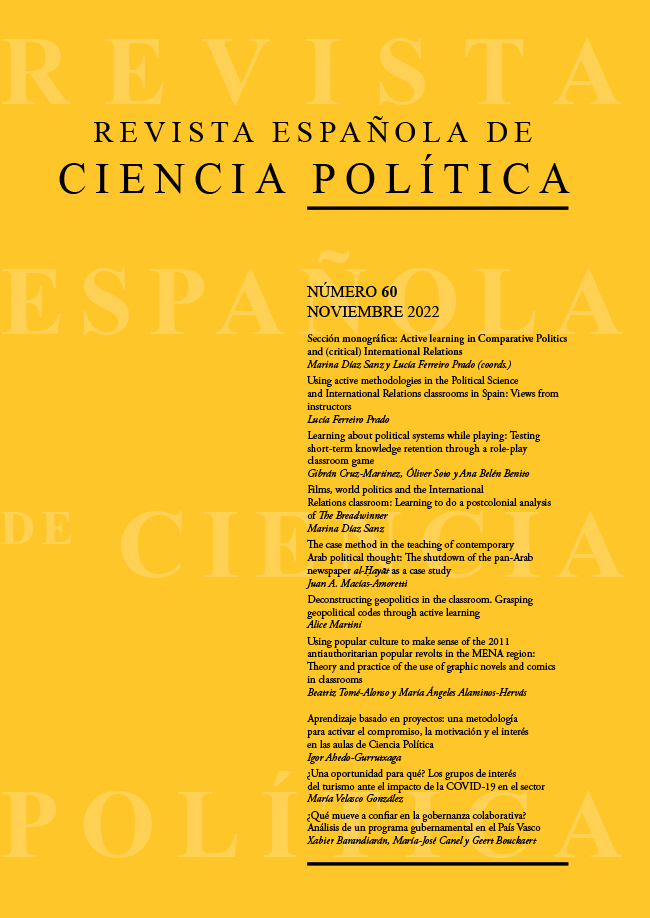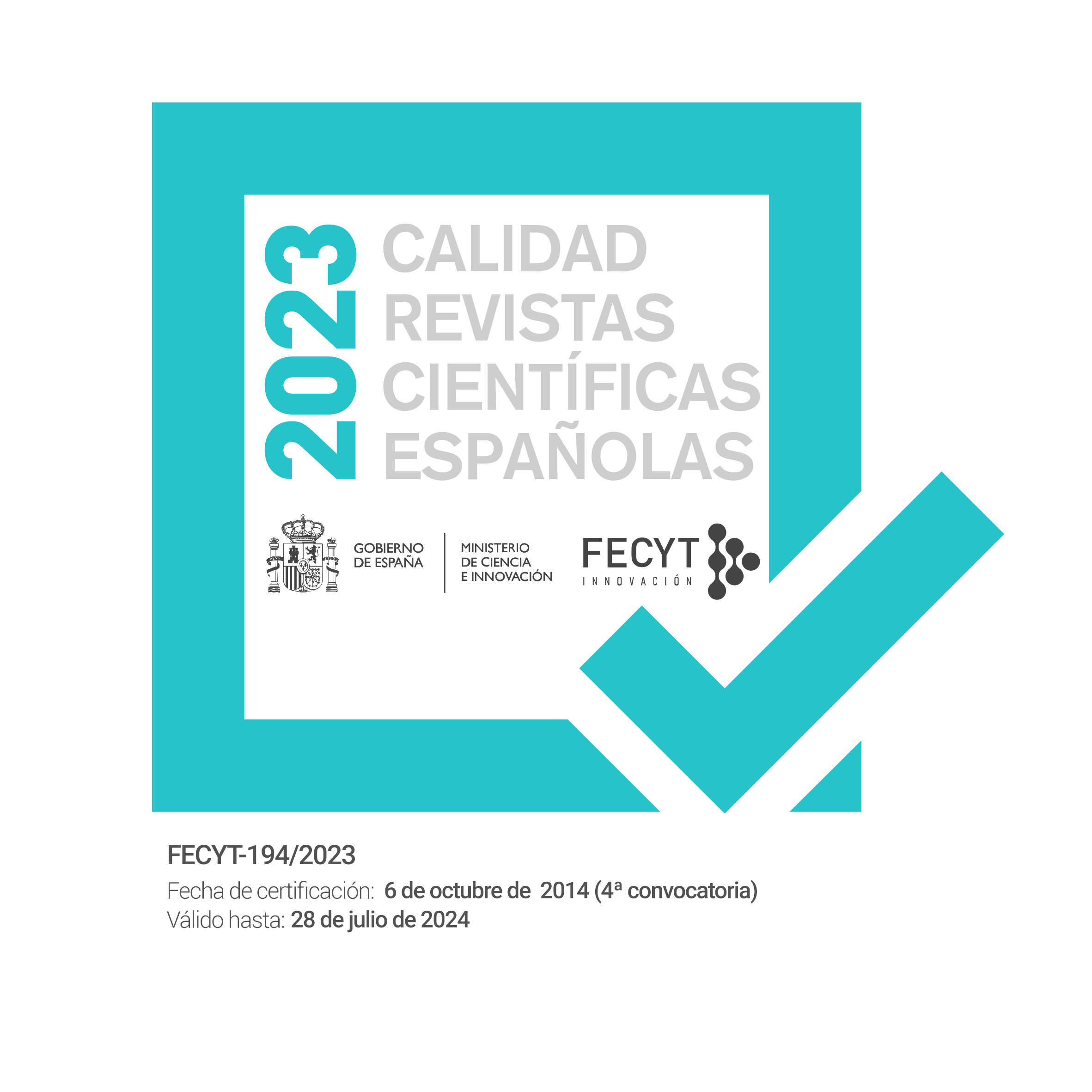Films, world politics and the International Relations classroom: Learning to do a postcolonial analysis of The Breadwinner
DOI:
https://doi.org/10.21308/recp.60.03Palabras clave:
relaciones internacionales, poscolonialismo, análisis de películas, aprendizaje activo, competencias de pensamiento crítico y analítico, análisis temático y narrativoResumen
Este artículo presenta y evalúa una actividad desarrollada en una asignatura sobre Oriente Medio. Los alumnos deben usar el poscolonialismo y la teoría del orientalismo en el análisis de una película sobre Afganistán. El propósito general es enseñar a leer la película en términos de los efectos de verdad que produce en lugar de como representación verdadera. La actividad se desarrolla en varias etapas y combina métodos activos de enseñanza —como el aprendizaje colaborativo— y tradicionales —como la clase magistral—. A lo largo del proceso se recogen datos en forma de reflexiones escritas de los estudiantes que se analizan con los métodos de análisis temático y narrativo. El artículo contribuye a la discusión sobre el aprendizaje de las relaciones internacionales con películas ofreciendo una aproximación detallada a un proceso de aprendizaje activo. Los resultados demuestran la mejora en la capacidad de pensamiento crítico de los estudiantes, con una evolución significativa desde lecturas centradas en la trama del filme hacia análisis posteriores que generan preguntas alrededor del punto de vista occidentalista de la película. La actividad también contribuye a la comprensión del potencial del poscolonialismo como enfoque de análisis de las relaciones internacionales, pero puede mejorarse la trasmisión de las limitaciones de este enfoque.
Descargas
Citas
Abu-Lughod, Lila. 2002. “Do Muslim Women Really Need Saving? Anthropological Reflections on Cultural Relativism and Its Others”, American Anthropologist, 104 (3): 783-790. Available at: https://doi.org/10.1525/aa.2002.104.3.783.
Barkawy, Tarak and Mark Laffey. 2002. “Retrieving the Imperial: Empire and International Relations”, Millennium, 31 (1): 109-127. Available at: https://doi.org/10.1177/03058298020310010601.
Bevir, Mark. 2006. “How Narratives Explain”, in Dvorah Yanow and Peregrine Schwartz-Shea (eds.), Interpretation and Method. New York and London: M. E. Sharpe.
Boyatzis, Richard E. 1998. Transforming Qualitative Information. Thousand Oaks, CA: Sage.
Bruffee, Kenneth A. 1995. “Sharing Our Toys. Cooperative Leaning Versus Collaborative Learning”, Change, 27 (1): 12-18. Available at: https://doi.org/10.1080/00091383.1995.9937722.
Chowdhry, Geeta and Sheila Nair. 2002. Power, Postcolonialism and International Relations. New York; London: Routledge. Available at: https://doi.org/10.4324/ 9780203166345.
Cohen, Mel. 1993. “Making Critical Thinking a Classroom Reality”, PS: Political Science & Politics, 26 (2): 241-244. Available at: https://doi.org/10.2307/419838.
Culcasi, Karen and Mahmut Gökmen. 2011. “The Face of Danger. Beards in the U.S. Media’s Representation of Arabs, Muslims, and Middle Easterners”, Aether: The Journal of Media Geography, VIII. B: 82-96.
Darby, Phillip and Albert J. Paolini. 1994. “Bridging International Relations and Postcolonialism”, Alternatives, 19 (3): 371-397. Available at: http://www.jstor.org/stable/40644813.
Díaz Sanz, Marina and Lucía Ferreiro Prado. 2021. “Orientalism is not my opinion: Decolonial teaching and the problem of credibility in IR courses with a MENA focus”, Politics. Available at: https://doi.org/10.1177/02633957211009068.
Falah, Ghazi-Walid. 2005. “The Visual Representation of Muslim/Arab Women in Daily Newspapers in the United States”, in Ghazi-Walid Falah and Caroline Nagel (eds.), Geographies of Muslim Women. New York: Guildford Press.
Ferreiro Prado, Lucía (ed.). 2020. Metodologías activas en las aulas de Ciencia Política y Relaciones Internacionales. Valencia: Tirant Lo Blanch.
Genovese, Michael. 1984. “Teaching Politics With Films”, News for Teachers of Political Science, 40: 1-5. Available at: https://doi.org/10.1017/S0197901900004268.
Gregg, Robert W. 1998. International Relations on Film. Boulder, CO: Lynne Rienner Publishers.
Hollis, Martin and Steve Smith. 1991. Explaining and Understanding International Relations. Oxford: Clarendon Paperbacks.
Hurd, Elizabeth S. 2003. “Appropriating Islam: The Islamic Other in the Consolidation of Western Modernity”, Critique: Critical Middle Eastern Studies, 12 (1): 25-41. Available at: https://doi.org/10.1080/1066992032000064174.
Inayatullah, Naeem and David L. Blaney. 2004. International Relations and the Problem of Difference. New York; London: Routledge. Available at: https://doi.org/10.4324/9780203644096.
Ishiyama, John, William J. Miller and Eszteter Simon (eds.). 2015. Handbook on Teaching and Learning in Political Science Education. Cheltenham: Edward Elgar Publishing.
Kratwohl, David R. 2002. “A Revision of Bloom’s Taxonomy: An Overview”, Theory into Practice, 41 (4): 212-218. Available at: https://doi.org/10.1207/s15430421tip4104_2.
Kuzma, Lynn M. and Patrick Haney. 2001. “And… Action! Using Film to Learn about Foreign Policy”, International Studies Perspectives, 2 (1): 33-50. Available at: https://doi.org/10.1111/1528-3577.00036.
Lamy, Steven L. 2007. “Challenging Hegemonic Paradigms and Practices: Critical Thinking and Active Learning Strategies for International Relations”, PS: Political Science and Politics, 40 (1): 112-116. Available at: https://doi.org/10.1017/S1049096507250279.
Lamont, Christopher. 2015. Research Methods in International Relations. London: Sage.
Lantis, Jeffrey S. 2013. “War and peace of film”, in Robert W. Glover and Daniel Tagliarina (eds.), Teaching politics beyond the book. Film, Texts and, New Media. New York: New Bloomsbury.
Lewis, Reina. 1996. Gendering Orientalism. Race, Femininity and Representation. London: Routledge.
Lobasz, Jennifer K. and Brandon Valeriano. 2015. “Teaching international relations with film and literature: using non-traditional texts in the classroom”, in John Ishiyama, William J. Miller and Eszter Simon (eds.), Handbook on Teaching and Learning in Political Science and International Relations. Cheltenham UK-Northampton, MA: Edward Elgar Publishing.
Loomba, Ania. 2015. Colonialism/Postcolonialism (3rd ed.). London: Routledge. Available at: https://doi.org/10.4324/9781315751245.
Manchanda, Nivi. 2020. Imagining Afghanistan. Cambridge: Cambridge University Press. Available at: https://doi.org/10.1017/9781108867986.
Prince, Michael. 2004. “Does Active Learning Work? A Review of the Research”, Journal of Engineering Education, 93 (3): 223-231. Available at: https://doi.org/10.1002/j.2168-9830.2004.tb00809.x.
Rose, Gillian. 2001. Visual Methodologies. London: SAGE.
Sabaratnam, Meera. 2011. “IR in Dialogue… but Can We Change the Subjects? A Typology of Decolonising Strategies for the Study of World Politics”, Millennium: Journal of International Studies, 39 (3): 781-803. Available at: https://doi.org/10.1177/0305829811404270.
Said, Edward W. 2003. Orientalism, 2nd ed. London: Penguin.
Seth, Sen. 2013. Postcolonial Theory and International Relations. A critical introduction. New York; London: Routledge. Available at: https://doi.org/10.4324/978020 3073025.
Simpson, Archie W. and Bernd Kaussler. 2009. “IR Teaching Reloaded: Using Films and Simulations in the Teaching of International Relations”, International Studies Perspectives, 10 (4): 413-427. Available at: https://doi.org/10.1111/j.1528-3585. 2009.00386.x.
Tomé-Alonso, Beatriz and Lucía Ferreiro Prado. 2019. “Mapping Orientalist Discourses: Using Waltz with Bashir in the Classroom”, International Studies Perspectives, 21 (2): 154-171. Available at: https://doi.org/10.1093/isp/ekz009.
Tuastad, Dag. 2003. “Neo-Orientalism and the new barbarism thesis: aspects of symbolic violence in the Middle East conflict(s)”, Third World Quarterly, 24 (4): 591-599. Available at: https://www.jstor.org/stable/3993426.
Twomey, Nora (dir.). 2017. The Breadwinner [film]. Studiocanal.
Valeriano, Brandon. 2013. “Teaching Introduction to International Politics with Film”, Journal of Political Science Education, 9 (1): 52-72. Available at: https://doi.org/10.1080/15512169.2013.747840.
Waalkes, Scott. 2003. “Using Film Clips as Cases to Teach the Rise and Decline of the State”, International Studies Perspectives, 4 (2): 156-174. Available at: https://doi.org/10.1111/1528-3577.402004.
Weber, Cynthia. 2001. “The Highs and Lows of Teaching IR Theory: Using Popular Films for Theoretical Techniques”, International Studies Perspectives, 2: 281-287. Available at: https://www.jstor.org/stable/44218170.
Wikipedia. n.d. “The Breadwinner (film)”. Available at: https://en.wikipedia.org/wiki/The_Breadwinner_(film)#Production.
Wolfe, Angela. 2012. “Implementing Cooperative Learning Methods in the Political Science Classroom”, Journal of Political Science Education, 8: 420-432. Available at: https://doi.org/10.1080/15512169.2012.729451.
Descargas
Publicado
Cómo citar
Número
Sección
Licencia
Derechos de autor 2022 Marina Díaz Sanz

Esta obra está bajo una licencia internacional Creative Commons Atribución-NoComercial-SinDerivadas 4.0.






